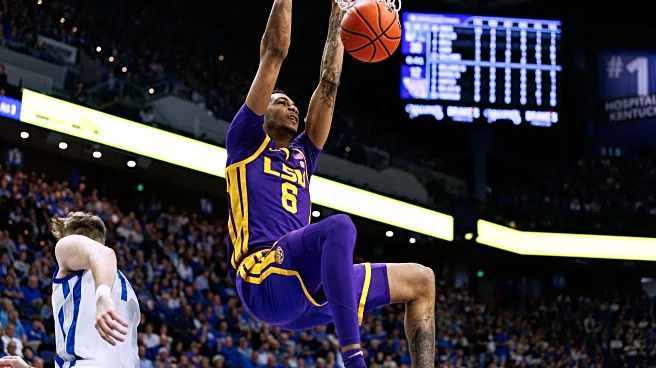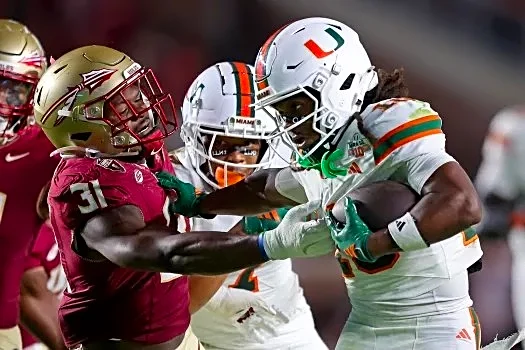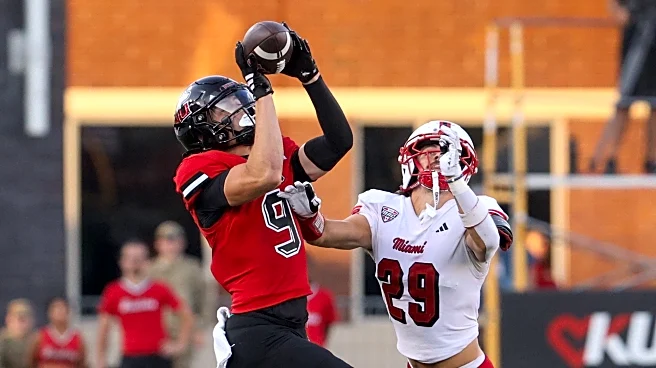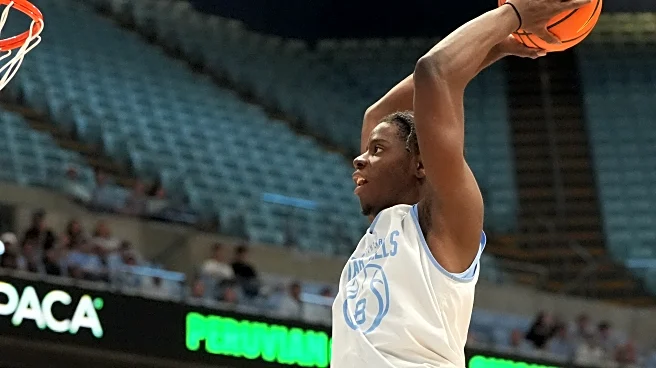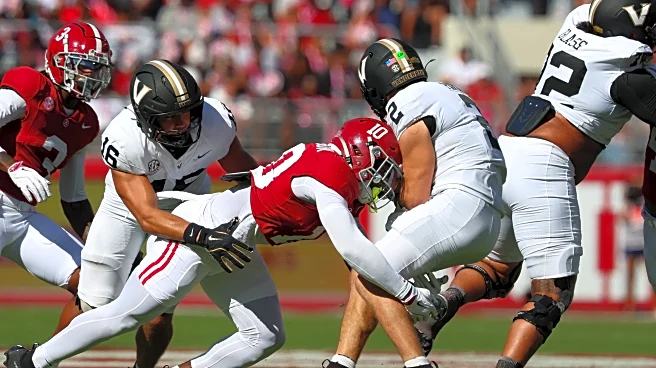I thought I knew what LSU was doing last year. From what you could tell at least, they were attempting to go against the grain and grow the program organically with young talent.
That’s a bold move in the day and age of instant fixes via the transfer portal. Why would you recruit and develop talented youngsters who might have a higher upside after some initial growing pains, when you could just buy a higher floor older player and be only marginally better?
Granted it didn’t work for LSU last season.
But the good news is it’s a new season and all of their highly recruited players from last years class are gone, and in their place is a shiny new portal haul.

LSU Tigers
- Last season: 14 – 18 (3-15 in conference) #88
- The Masses Prediction: 15th in conference, 4.91 – 13.09
- SEC Media: Coming October 15th
- Analytics Average: 15th in conference, 63th overall

HEAD COACH: Matt McMahon | 4th Season, 45-53
When LSU brought in McMahon the hire generated positive reviews, but it has not gone well. McMahon worked a bit of a slow burn at Murray State, so anyone expecting instant results in Baton Rouge were probably overestimating the hire, but given time and resources the belief was McMahon would build a consistent product. And he would do it in a way that wasn’t like Will Wade, who’s now at North Carolina State, but left with a much larger black cloud hanging over him.
It doesn’t matter that Wade cheated, even if the form of buying players is now legal. It should matter, but it doesn’t. LSU fans have since watched Wade have two fantastic seasons at McNeese State before being hired in Raleigh this past offseason. What matters is that Wade was successful, earning three NCAA bids and there would have been 4 if the tournament happened in 2020.
The problem is McMahon hasn’t won. They had a mediocre season in between two bad ones. The best season two years ago was a poor 9-9 year which included a home loss to Nicholls State and a 17-16 overall record. But the new trend with coaches is to give them NIL money instead of a buyout to see if they can turn it around. With no evidence to support a turnaround, McMahon went into the portal with a nearly fully flipped roster, and abandoned the young talent they accumulated over the previous years.

LSU isn’t boring! That’s one thing you can say about them, things are rarely dull, even if there isn’t a lot of success. Despite some historical success, LSU has never really been able to build a sustainable thriving program. It’s one of the most hot & cold programs in the country. They have 4 Final Fours in program history, which is akin to a top 30 level program for appearances, and tied with Arizona. But they’re 49th in NCAA Appearances (with 24), and 46th in the final AP poll vote with 13.
LSU has shown they can be good, they are sometimes good. They aren’t consistently good.
LOST PRODUCTION
15th in % minutes, 89.34% | 13th in % points, 90.18% | 15th in % possessions, 91.61%
Everyone is gone… basically.
LSU was bad last year. Contextually they were bad for the best league in the (at least recent) history of college basketball. In a regular year, LSU’s 88th rating in KenPom likely would have settled them into 10th or 11th instead of 15th. But forging through a league with a record setting number of NCAA berths left LSU floundering for much of the season. The league was just unforgiving for a team with any level of variance. They had wins over Kansas State, UCF and Florida State in the non-conference, with losses to Pitt and SMU. They lost 15 conference games, 16 if you count the SEC tournament. And each loss was to a team who made the NCAA Tournament.
Every game from the beginning of January on was against a team ranked 48th or higher, save for one. LSU won that one game, against South Carolina. So LSU was less a bad team, but just not a very good one in a bad year to not be very good.
So everyone either entered the transfer portal or graduated. Gone to graduation are Cam Carter and Jordan Sears, the only double digit scorers, and promising young players Corey Chest, Vyctorius Miller, and Curtis Givens are all gone via the transfer portal.


Last year I was still mostly buying McMahon as a solution, if only because it was easy to buy in with good quality recruiting, and he was landing a lot of quality 4-stars. Give those players enough runway and things generally work out. Only last season blew it up, McMahon pulled the plug, and then went into the portal. But the portal has far more misses than success stories! So what’s going with the haul in Baton Rouge?
The Tigers retained just two players from last season in Robert Miller and Jalen Reed. Reed was playing starter minutes but tore his ACL in early December against Florida State. After 8 games Reed was averaging 11.1 points and 6.5 rebounds and the Jackson, MS native was looking like the best player on the roster. So McMahon is hoping to get Reed back healthy and producing again. Backup post Robert Miller played sparingly early but more as the season wore on, and he showed promise.
McMahon went hard into the transfer portal and the results here look a bit mixed. Coming in are multiple players who were productive at their last stop. Defensively LSU was ok a year ago, but the offensive side of the ball was a struggle unless Cam Carter was having a night. So most of the imports were guys who were primary operators on their team before.
Marquel Sutton averaged 18.9 points, Rashad King averaged 18.5, Dedan Thomas averaged 15.6, and Max Mackinnon averaged 14.5. But on top of the scoring, each import brings in something LSU was missing last year: experience.
A season ago the Tigers were the 4th least experienced team in the league in terms of games and minutes played at the Division I level. They were also amongst the lowest in returning minutes and games played. This season McMahon has flipped that result going from virtually no experience to a lot of experience, but sticking with an overall lack of continuity.
Sutton, from Omaha, leads the way with 99 games played and 3,062 minutes. Mackinnon, via Portland, is next up with 95 games and 2,678 minutes. King, a Northeastern transfer, has seen action in 92 games over three years. In total LSU has imported 570 games played, and 13,702 minutes, last year it was less than half that.


Usually when a team imports so much production it’s difficult to predict how the roles will slot. There does appear to be some coherence in the construction. They imported a ball dominant point guard (Thomas), a high usage wing (King), a low usage wing (Mackinnon), and then a flexible forward who can play both on the wing or around the basket in Sutton.
However if you’re a buyer into EvanMiya.com’s BPR, none of these players really stand out. The best rated projected starter in this group is Thomas at 3.71, which is good for the 52nd best player in the league. Last year Cam Carter was rated as the 56th best player in the league by the end of the season. Their highest rated player in projections is sophomore forward Robert Miller, and much of that comes from the defensive end. Even with Rock M+‘s PAR ratings there are only two players in the top 100 projected into the starting five.
The projections do like sophomore post Robert Miller, but Miller was a rotational big thrust into playing time when Jalen Reed went down last year. Much of his impact was on the defensive end, this year he’ll contend with a healthy Reed and Mississippi State transfer Michael Nwoko, who was a starter last year.
McMahon is likely going to be counting on Rashad King to scale up his production from Northeastern, where he was the best player on a bad team. Or perhaps Marquel Sutton can step it up after transferring from Omaha. Horizon League transfers usually have a tougher time scaling up their production.


This is what you call a soft entry. But there’s a big difference between their Quad 1 games: SMU is on the back end of the top 50, and Texas Tech might be a top 10 team this year. The rest of the schedule is quite manageable with a road game against a lower tier ACC team like Boston College.
But 8 quad 4 games is a lot of quad 4 games. Matt McMahon has to know he can’t miss on any of those games, and likely needs to pick off three more at least. Then the conference schedule hasn’t really done them any favors other than getting South Carolina twice, which feels like two must win games. The softest road game is Ole Miss. Looking at this slate, the best case scenario is probably around 8 conference wins. And that’s sweeping South Carolina, splitting with Texas A&M, and winning at least three home games.
THE RULING
Four years ago when Matt McMahon accepted the job at LSU the landscape was really very different. It’s hard to imagine how much has changed in the last four years, but the LSU brass were accustomed to making big splash hires and they went with the Murray State coach who had been in place with the Racers for 7 seasons. They made this move because the basketball brand was toxic for having Will Wade as head coach. The irony of Wade’s success coming at the expense of coaches who weren’t paying players and now McMahon’s struggles are because of coaches who can pay players is not lost on many.
But instead of taking a coach steering a floundering program and kicking them to the curb, Boosters are instead injecting cash into the NIL coffers to see if the coach can turn it around. But injecting money to go buy a better roster isn’t a dead on answer.
The bones of this LSU roster flip aren’t as bad as this record might indicate. It’s decent enough. There are some solid guards, some shot makers, there are some interior big bodies.
What is it that LSU does well? The last few years have been marred by mediocre offense and questionable defense. The Tigers haven’t shared the ball well, and their shooting has rarely been good.
There are paths forward with this roster for things to not be this bad. For one, Jalen Reed has to return to health and be the level of player LSU was hoping he would be all last season. Reed flashed in a few games but his production was still inconsistent before he went down with an injury. He put up 21 points against UCF and 24 against Louisiana Monroe, but chipped in just 5 points against Kansas State and 6 against Alabama State. That isn’t going to be enough for LSU to avoid a Wednesday play-in. Mostly because I’m not sure he’s going to get help from Michael Nwoko beyond what Nwoko provided Mississippi State last year.
Or maybe Robert Miller can take a step forward offensively?
If LSU can find some consistent production around the rim there’s at least a little ray of hope. With Dedan Thomas, Jr. and Rashad King, there should be enough offense around the perimeter to be competitive. If the bigs can come along with them LSU might be able to fight onto the bubble.
My Results: LSU Tigers — 16th in Conference, 3-15
About the preview: a number of respected basketball bloggers were asked to submit one pick for the entire league schedule game by game. The game by game option allows us to account for the unbalanced schedule when addressing any kind of power rankings. Each set of picks are reflected in “the Masses” picks. Included in “the Masses” are various SEC media members who made picks at my request, as well as additional credit given to the analytics projections.
If you’d like to submit your picks, click here for the Google Form we used. If you want to know your results, send me an email.
Additionally, instead of relying solely on KenPom.com for the analytics site projections, we’re taking the average of the four main sites (EvanMiya.com, BartTorvik.com, Haslametrics.com, and KenPom.com) to give a closer consensus picture. These are weighted a touch for reliability.
The projections: This is new! In an attempt to be as accurate as we could be we increased the amount of analytics used to make individual projections which influenced how these teams slotted in order. Matt Watkins used an in-depth method for projecting the entire SEC transfer list, we then mixed in EvanMiya.com’s BPR projections, and BartTorvik.com’s preseason individual projections to round out the expected production based upon how each coach routinely uses his rotations.
GLOSSARY
* – an asterisk denotes a walk-on player
GP – Games Played
%min – percentage of total available minutes played, does not account for time missed due to injury
%poss – percentage of team possessions the player is responsible for ending a possession, whether by making a shot, missing a shot not rebounded by the offense or committing a turnover. For returning players this is noted as a percentage of total team possessions. For newcomers it was total possessions when that player was on the floor, better known as Usage Rate.
ORtg – Offensive Rating, similar to a points per possession but averaged out over 100 possessions. So it’s how many points a player would score if they were responsible for 100 possessions.
BPR – Bayseian Performance Rating, a single player efficiency metric created by Evan Miyakawa to determine both offensive and defensive impact when a player is on the floor.
PAR – Points Above Replacement, a Rock M+ proprietary rating measuring projected on-off impact adjusted for time on the floor.
PPG – Points Per Game, RPG – Rebounds Per Game, APG – Assists Per Game: All traditional statistics used to measure player production.
For newcomer player rankings, we used EvanMiya.com’ s rankings for transfers, and 247sports.com ‘s Composite Rating for Freshmen and Junior College signees.
